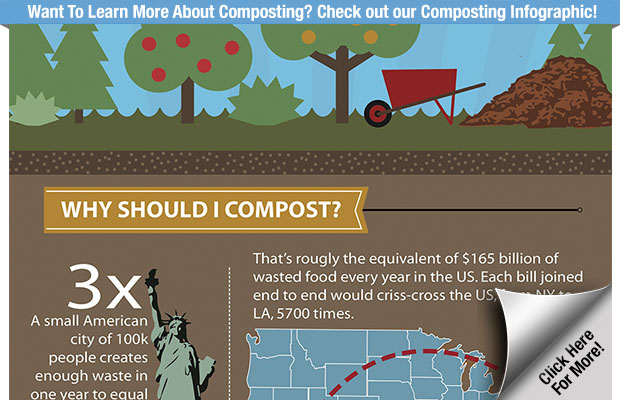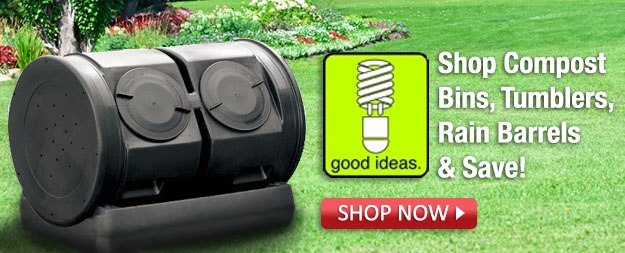Composting is a great way to reduce waste while creating a valuable product to produce healthier soil for healthier plants. While it’s not difficult, many people are sometimes intimidated by the process or are unsure about what composting is all about. The infographic and other information on this page is a great place to start learning about composting and how to compost.
Composting Infographic
(Click to enlarge)
What Is Compost?
Composting is a process of taking raw organic materials and purposely facilitating decomposition in a controlled setting with the ideal conditions and materials to produce a valuable soil amendment. Adding compost to your soil will help break up heavy soils improving drainage, make nutrients available to plants, improve water retention, and generally improve soil quality for healthier plants. It can be used as mulch for plants in the garden or landscape, or mixed into soil as a soil amendment. In clay soils it will improve aeration, root penetration, and watering, while sandy soils get help in nutrient and water retention. In all cases, adding in compost will increase soil microbe activity, releasing more nutrients into the soil.
Reasons To Compost
There are many reasons to start or contribute to a compost pile besides just improving your soil quality:
- Composting can reduce household waste by 30 percent
- Twenty percent of all U.S. household landfill waste is food
- Can reduce soil fertilization costs by 50 percent
- A small American city of 100 thousand people creates enough waste in one year to equal the weight of three Statues of Liberty.
- That’s roughly the equivalent of $165 billion in food waste every year in the U.S. Each bill joined from end to end would criss-cross the U.S., from NY to LA, 57,000 times.
- Compost naturally, and inexpensively, feeds plants a wide range of necessary macronutrients and micronutrients.
- Composting increases volume of water by three quarts by cubic foot in soil. That means less frequent watering!
- Composting dramatically lightens up the soil by providing a habitat for worms where they can feed on decaying plant matter and aerate the soil with their tunneling
Compost materials
Before you get going making compost, you’ll need to know what exactly you can throw in the mix. Essentially, any organic material can be introduced into your compost mixture.
- Plant materials: most all plant materials can be added in to compost, including pine needles, grass clippings, garden debris, fallen leaves, brush, branches, etc.
- Kitchen scraps: Fruit and vegetable scraps, like peels and cores and left-overs can be thrown in, as well as egg shells, tea bags, and coffee grounds.
- Paper products: Often, paper bags, cups, and shredded paper scraps can be added in as well.
- Do not add meats, oils, fats, bones, or other animal products, as they might make your compost extra smelly and could attract animals to see your pile as a food source.
0ur composting graphic (at the top of this page) has a great chart that lists proper ratios for adding in material to your compost pile. They’re separated into greens (mostly food wastes plus manure) and browns (mostly yard and garden debris, including paper). The ratios are in place to help keep your compost balanced, ensuring there’s enough carbon and nitrogen in your mix to create a successful final product.
Common Browns: Common Greens:
-Dry leaves 70:1 -Grass clippings 17:1
-Shredded paper 175: 1 -Rotten fruits and vegetables 30:1
-Evergreen needles 80:1 -Manures 20:1
-Wheat straw 90:1 -Coffee grounds 25:1
-Wood chips 500:1 -Garden waste 30:1
-Nut shells 80:1 -Breads and grains 17:1
How To Make Compost
There are key things to keep in mind when building a compost pile. Aeration, moisture, temperature, and surface area of the pieces, as well as the proper carbon/nitrogen ratio, are all important factors in decomposition. Here are some tips in building a compost pile:
- Decomposition is best in a composting bin or box, at least 5x5x3 feet.

- While you can build a pile directly on the ground, digging a trench and filling it with hardware cloth will help with drainage and aeration.
- Building the pile in layers can help create the optimal mix of materials. Starting with a six to eight inch layer of organic materials (green category) followed by a small (2 inch) layer of fertilizer or manure, and finally a thin layer of soil or sod, and repeat as you obtain more material. Moisten each layer as you add it, so it is as wet as a wrung-out sponge. It is easier to moisten as you add each addition rather than trying to moisten an entire pile.
- The more surface area on each particle of composting material, the faster and better they will decompose. The smaller pieces, the better, so you may have to run wood through a chipper and break up any large pieces.
- Mix the pile every week to aerate it, watering it when mixture appears dry (spray with a spray bottle, do not soak).
- The pile should be about 110 degrees after a week in the summer and after about a month in cooler or cold months. Check interior temperature (at least 12 inches from surface) and then try to mix the outer and top into the middle.
- Depending on the season, expect to have your first usable compost in around three to four months. Compost is ready when it appears dark in color, with an earthy smell and crumbly texture. Break up large pieces for a finer texture, or use large pieces for mulch.
Common Compost Problems
There are a lot of steps involved in building a strong compost pile, but just keep in mind that your pile will decompose even if you forget about it for months. However, it will take longer than using a structured method. If you run in to some problems, the solutions are fairly simple and don’t threaten to ruin your hard work. Some common problems include:
- A strong, unpleasant odor: this may occur if the pile is too wet or too tightly compacted. Loosen up and turn the pile. If you notice it is too wet, add in some dry compost materials. If the smell doesn’t get better, it may indicate there are some animal products like fat or meat in the pile.
- Little to no decomposition: If no decomposition has occurred, it may be that your pile is too dry. Add in moisture while turning your pile, so that all levels are moistened. If it’s moist with a warm temperature but not quite warm enough, it may need more nitrogen, or your pile is too small. Add volume to your pile or add in some nitrogen rich fertilizer or other material. If there is a sweetish smell coming off your moist compost pile, there is likely too little nitrogen.
*Remember, if you are running into difficulty or need more information, or directions, utilize your local resources, like your local master gardener or extension office.




